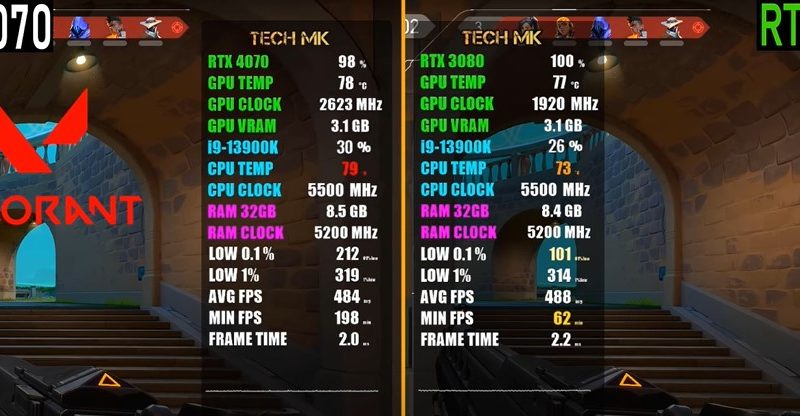4070RTX Laptop GPU vs 3080RTX Laptop GPU
TL;DR: To fully grasp the performance differences and make the most informed choice, it’s essential to understand the impact of DLSS and GPU wattage on GPU performance for both gaming and productivity.
1. Specs: 4070RTX vs 3080RTX
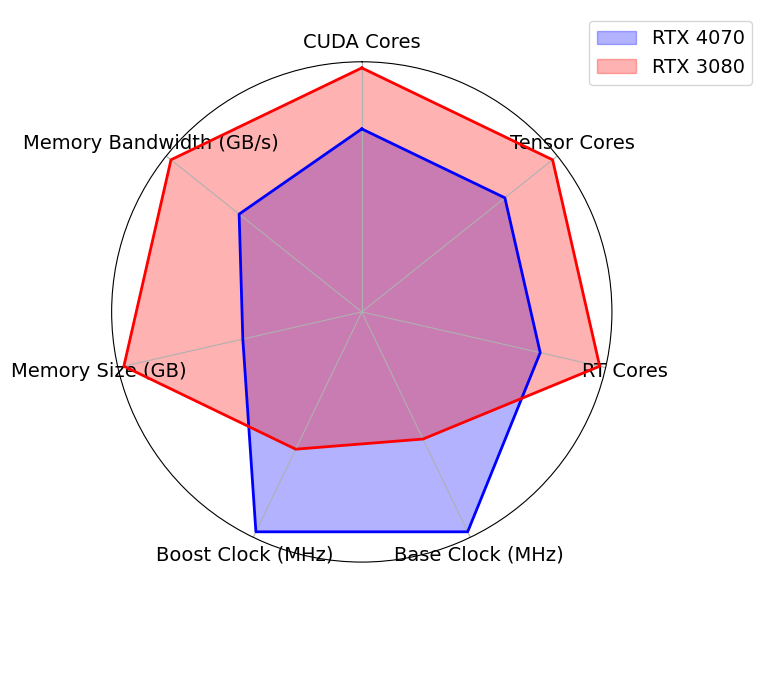
| Feature | RTX 4070 (Laptop) | RTX 3080 (Laptop) |
|---|---|---|
| Architecture | Ada Lovelace | Ampere |
| CUDA Cores | 4608 | 6144 |
| Tensor Cores | 4th Generation | 3rd Generation |
| RT Cores | 3rd Generation | 2nd Generation |
| Base Clock | 2070 MHz | 1110 MHz |
| Boost Clock | Up to 2175 MHz | Up to 1710 MHz |
| Memory | 8 GB GDDR6 | 8/16 GB GDDR6 |
| Memory Bus | 128-bit | 256-bit |
| Memory Bandwidth | 288 GB/s | 448 GB/s |
| TGP (Typical Range) | 35-115W (140W with Dynamic Boost) | 80-150W (165W with Dynamic Boost) |
| Ray Tracing Support | Yes | Yes |
| DLSS Support | DLSS 3 (Frame Generation) | DLSS 2 |
| Max Resolution | 8K | 8K |
| Process Node | 4 nm | 8 nm |
1. Architecture and Efficiency
- Ada Lovelace (RTX 4070):
- Built on a smaller 4 nm process node, offering higher efficiency and better thermal performance.
- Supports DLSS 3, which includes frame generation, providing smoother gameplay in supported titles.
- More power-efficient, making it ideal for portable, thin-and-light laptops.
- Ampere (RTX 3080):
- Built on the 8 nm process node, less power-efficient compared to Ada Lovelace.
- No support for frame generation but strong in traditional upscaling tasks like DLSS 2.
Implications: The RTX 4070 is better suited for modern laptops prioritizing efficiency and longer battery life, while the RTX 3080 requires robust cooling for optimal performance.
2. CUDA Cores
- RTX 3080 has 6144 CUDA cores, significantly more than the 4608 on the RTX 4070.
- This gives it an edge in raw parallel computing tasks, like 3D rendering and simulations.
- RTX 4070 compensates with higher clock speeds and architectural improvements.
Implications: The RTX 3080 will excel in CUDA-heavy tasks, such as Blender rendering and scientific simulations, while the RTX 4070 offers competitive performance in lighter workloads and modern, optimized software.
3. Memory and Bandwidth
- RTX 3080: Offers a wider 256-bit memory bus and up to 448 GB/s bandwidth, enabling faster data transfer.
- RTX 4070: Limited to a 128-bit memory bus with 288 GB/s bandwidth but benefits from architectural efficiency.
Implications:
- The RTX 3080 performs better in high-resolution gaming (4K) and memory-intensive applications like video editing and 3D rendering.
- The RTX 4070 is better optimized for 1080p and 1440p gaming, where bandwidth demands are lower.
4. Ray Tracing and AI Performance
- RTX 4070: Equipped with 3rd-gen RT cores and 4th-gen Tensor cores, delivering improved ray tracing and AI-based features like DLSS 3.
- RTX 3080: Uses 2nd-gen RT cores and 3rd-gen Tensor cores, strong but less advanced than the RTX 4070.
Implications:
- The RTX 4070 is better for modern games with heavy ray tracing or AI-enhanced features like DLSS 3 frame generation.
- The RTX 3080 still performs exceptionally well in traditional ray tracing and rendering tasks.
5. TGP (Thermal Design Power)
- RTX 3080: Higher TGP (up to 165W) translates to better raw performance but requires superior cooling.
- RTX 4070: More efficient, achieving comparable performance at lower TGPs.
Implications:
- The RTX 3080 shines in laptops with robust cooling systems, suitable for desktop replacements.
- The RTX 4070 is ideal for thinner laptops or users prioritizing battery life and thermal management.
2. Benchmarks: 4070RTX vs 3080RTX
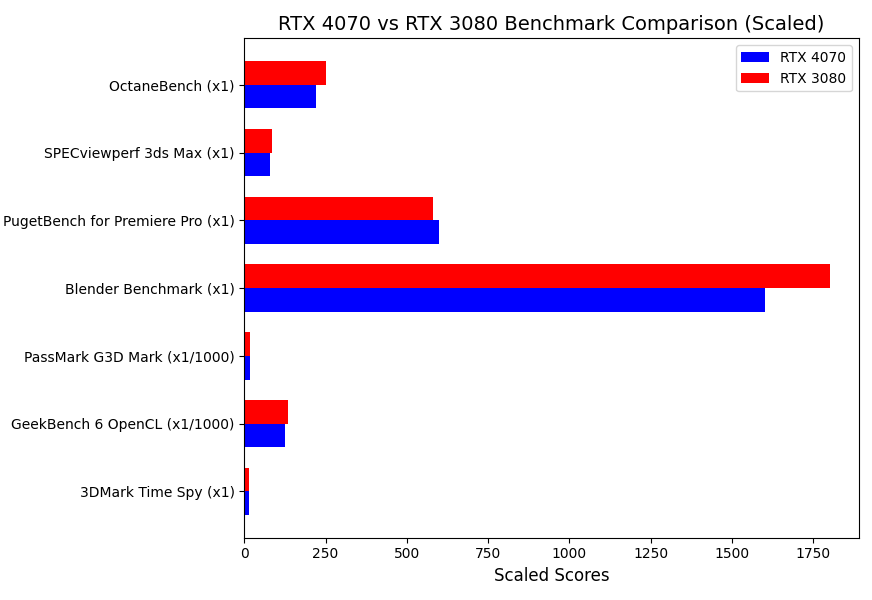
Important Nuances to Consider
TGP Variations
Performance for both the RTX 4070 and RTX 3080 Laptop GPUs can vary significantly depending on their TGP (Total Graphics Power). Laptops with higher TGP configurations (e.g., 140W) will typically deliver better performance, whereas lower TGP models (e.g., 80W or 100W) may see reduced scores. This factor is crucial in determining real-world differences between these GPUs.
Cooling System
A robust cooling solution plays a critical role in maintaining consistent performance. In laptops with poor cooling, thermal throttling can significantly reduce performance, often narrowing the gap between the GPUs.
CPU Pairing
The CPU’s performance influences tasks heavily dependent on both GPU and CPU, such as rendering or gaming at high frame rates. A less powerful CPU may bottleneck either GPU, particularly the RTX 3080, which thrives in raw compute-heavy tasks.
3DMark Time Spy
- RTX 4070: 13,350 points
- RTX 3080: 13,750 points (~3% higher)
The RTX 3080 marginally outperforms the RTX 4070 in this DirectX 12 benchmark, highlighting its raw compute capabilities. The RTX 4070, however, benefits from Ada Lovelace architecture’s improved efficiency and DLSS 3 support, which can significantly enhance performance in modern games.
- In lower TGP configurations, the RTX 4070’s architectural efficiency may allow it to sustain performance more consistently than the RTX 3080.
- High-TGP laptops with better cooling solutions may enable the RTX 3080 to leverage its higher CUDA core count more effectively.
GeekBench 6 Compute
- RTX 4070: 125,000 points
- RTX 3080: 135,000 points (~8% higher)
The RTX 3080 leads in this compute benchmark, showcasing its advantage in CUDA-heavy workloads like image processing, simulations, or machine learning. The RTX 4070 remains competitive, especially in AI-driven workflows optimized for Ada Lovelace.
- Tasks utilizing Tensor cores and AI features (e.g., deep learning inference in TensorFlow) may see better performance on the RTX 4070 due to its newer architecture.
- The RTX 3080 excels in workloads requiring raw compute power, benefiting from its higher CUDA core count.
PassMark G3D Mark
- RTX 4070: 17,550 points
- RTX 3080: 18,500 points (~5% higher)
The RTX 3080 maintains an edge in this general-purpose GPU benchmark, thanks to its higher core count and bandwidth. However, the RTX 4070 demonstrates strong efficiency, making it an excellent choice for modern gaming and productivity tasks.
- Memory-intensive workloads (e.g., 4K rendering or large simulations) may benefit from the RTX 3080’s wider memory interface and higher bandwidth.
- The RTX 4070 could deliver better power efficiency in laptops with constrained cooling or power budgets.
Blender Benchmark
- RTX 4070: 1,600 points
- RTX 3080: 1,800 points (~12.5% higher)
The RTX 3080 outperforms the RTX 4070 in Blender’s rendering benchmark, leveraging its higher CUDA core count and memory bandwidth. This makes it a better choice for professionals working in 3D modeling and rendering.
- Real-time rendering tasks in tools like Blender’s Eevee engine may favor the RTX 4070 due to Ada Lovelace optimizations.
- In thermally constrained environments, the RTX 4070’s efficiency may close the performance gap.
PugetBench for Premiere Pro
- RTX 4070: 600 points
- RTX 3080: 580 points (~3.4% lower)
The RTX 4070 slightly edges out the RTX 3080 in Premiere Pro, benefiting from architectural improvements that enhance GPU-accelerated video editing tasks. This includes faster effects rendering and smoother timeline performance.
- The RTX 3080’s higher memory bandwidth may still provide advantages in heavy workloads like 8K video editing.
- AI-powered tools (e.g., Lumetri Color grading) may see better performance on the RTX 4070 due to newer Tensor core optimizations.
SPECviewperf 3ds Max
- RTX 4070: 80 FPS
- RTX 3080: 85 FPS (~6% higher)
The RTX 3080 outperforms the RTX 4070 in this professional 3D modeling benchmark, highlighting its raw performance advantage for rendering large-scale models.
- Modern 3D workflows utilizing AI-based denoising and real-time ray tracing could favor the RTX 4070.
- Complex scene rendering with extensive memory requirements may still benefit from the RTX 3080’s larger bandwidth.
OctaneBench
- RTX 4070: 220 points
- RTX 3080: 250 points (~12% higher)
The RTX 3080’s superior CUDA core count and memory bandwidth make it the better option for OctaneBench, which heavily relies on raw GPU compute power for rendering.
- Smaller, real-time rendering tasks may show similar performance between the two GPUs, especially in laptops with limited TGP.
- The RTX 4070’s lower thermal output may result in more consistent performance during extended workloads.
3. Performance: 4070RTX vs 3080RTX
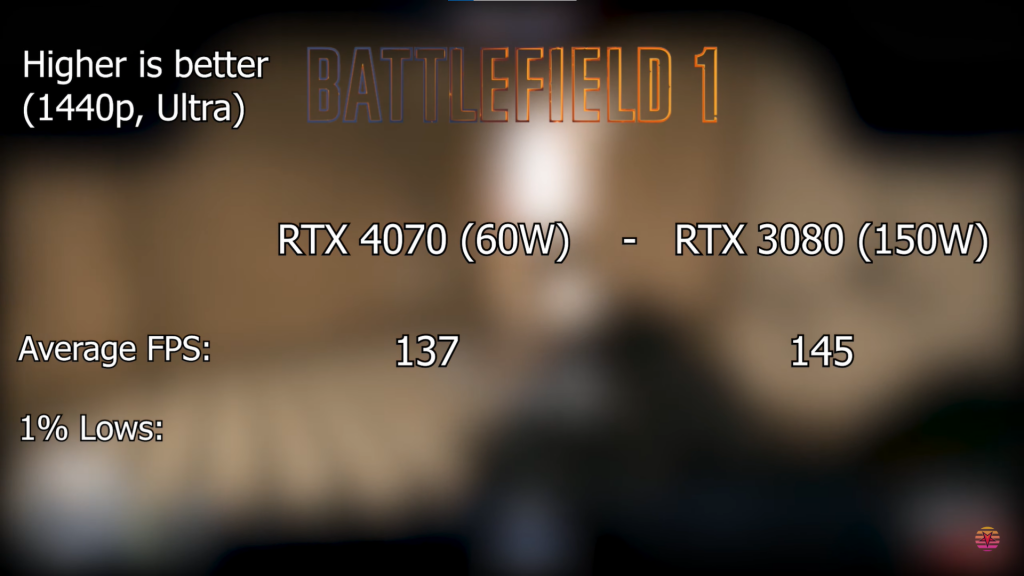
Gaming
High-TGP Configurations (140W RTX 4070 vs. 140W RTX 3080)
- Without DLSS: The RTX 3080 demonstrates superior raw gaming performance at 1440p and 4K, leveraging its 16GB VRAM, 256-bit memory interface, and higher memory bandwidth to handle large textures and high-resolution demands in games that rely purely on brute-force rendering power.
- Example: In games like Microsoft Flight Simulator or Hogwarts Legacy at native resolutions and max settings, the RTX 3080 performs better due to its memory capacity and higher CUDA core count.
- With DLSS: The RTX 4070, featuring DLSS 3, frame generation, and Ada Lovelace optimizations, often delivers similar or better performance in modern titles optimized for these features, particularly at 1080p and 1440p resolutions.
- Example: In Cyberpunk 2077, enabling DLSS 3 with frame generation allows the RTX 4070 to achieve higher and smoother frame rates, narrowing or surpassing the RTX 3080’s advantage in certain scenarios.
- At 140W, the RTX 4070 has been reported to offer 20-25% better performance than the RTX 3080 in modern DLSS-optimized games.
- Example: A 140W RTX 4070 paired with an HX CPU and robust cooling system can outperform the RTX 3080 in titles leveraging Ada Lovelace features like DLSS 3 and real-time AI-assisted rendering.
Low-TGP Configurations (60W RTX 4070 vs. 150W RTX 3080)
- The RTX 4070 (60W), despite significantly lower power consumption, achieves similar or higher FPS in optimized titles utilizing DLSS 3 and frame generation. Its power-efficient architecture allows it to perform well even in thermally constrained environments.
- Example: In Horizon Forbidden West at 1440p with Very High settings (medium texture quality) and frame generation enabled, the RTX 4070 delivers smooth frame rates at 2600MHz, demonstrating excellent efficiency.
- The RTX 3080 (150W) delivers superior performance at higher resolutions (e.g., 1440p and 4K) in non-DLSS scenarios, benefiting from its 16GB VRAM, higher memory bandwidth, and CUDA core count.
- Example: In VRAM-intensive games or non-DLSS-optimized titles, such as Hogwarts Legacy or Ratchet & Clank, the RTX 3080’s larger memory pool gives it an advantage.
- In thermally constrained environments, the RTX 4070 outperforms due to its architectural efficiency and lower power demands. The RTX 3080, with higher power requirements, is more prone to throttling in laptops with limited cooling.
- Example: In less demanding games like Overwatch 2, the RTX 4070 maintains stable frame rates, making it a better option for thin-and-light laptops.
- Nuance: For Ultra settings and games requiring large VRAM allocations, such as 4K textures or poorly optimized games, the RTX 3080 may maintain an edge due to its 16GB VRAM.
Video Editing
High-TGP Configurations:
- The RTX 3080 excels in 8K video editing workflows or projects involving large video files, benefiting from its higher memory bandwidth and CUDA core count.
- The RTX 4070 is competitive in 4K workflows, particularly when leveraging AI-accelerated tools (e.g., Adobe Sensei), which improve efficiency and rendering times.
- Example: Rendering a 10-minute, heavily edited 8K video with GPU-accelerated effects is faster on the RTX 3080, while 4K projects using AI-driven tools in Adobe Premiere Pro are often completed more efficiently on the RTX 4070.
Low-TGP Configurations:
- The RTX 4070 shines in light editing workflows (e.g., 1080p to 4K) where its architectural improvements and efficiency maintain steady performance.
- The RTX 3080 may struggle in laptops with constrained cooling systems, reducing its performance advantage over the RTX 4070 in these scenarios.
3D Rendering and Modeling
High-TGP Configurations:
- The RTX 3080 is better suited for memory-intensive rendering tasks in tools like Blender Cycles or V-Ray, leveraging its higher CUDA core count and wider memory bandwidth.
- The RTX 4070 performs well in real-time rendering workflows, particularly in AI-assisted tasks like denoising or DLSS 3-supported visualization.
- Example: Rendering a complex 3D scene in Blender is faster on the RTX 3080, while real-time previews and AI-enhanced effects in Unreal Engine 5 benefit from the RTX 4070’s Ada Lovelace features.
Low-TGP Configurations:
- The RTX 4070 maintains efficiency and excels in low-power scenarios, particularly for AI-assisted workflows or light modeling tasks.
- The RTX 3080, with its higher power and thermal demands, may lose its edge in laptops with limited cooling, giving the RTX 4070 the advantage in such configurations.
AI-Assisted Applications
High-TGP Configurations:
- The RTX 4070 benefits from 3rd-generation Tensor cores and Ada Lovelace optimizations, excelling in AI workloads such as deep learning inference, image enhancement, and other AI-driven tools.
- The RTX 3080, with more Tensor cores, remains strong in traditional AI compute tasks, such as neural network training, where core count is crucial.
- Example: Training a neural network may run faster on the RTX 3080, while inference tasks like image upscaling in Topaz AI or noise reduction in DaVinci Resolve are more efficient on the RTX 4070.
Low-TGP Configurations:
- The RTX 4070 consistently outperforms in AI workflows under constrained environments, thanks to its power efficiency and Ada Lovelace optimizations.
- The RTX 3080 may lose its Tensor core advantage due to throttling or reduced efficiency in low-TGP configurations.
General GPU Performance
High-TGP Configurations:
- The RTX 3080 excels in memory-bound tasks, such as 4K rendering, video editing, or simulation workloads, where its bandwidth and CUDA core count provide a clear advantage.
- The RTX 4070 offers better performance in modern applications that leverage DLSS 3, frame generation, and real-time AI features, making it a more future-proof choice.
- Example: In general-purpose GPU benchmarks like PassMark, the RTX 3080 leads in memory-bound tasks, but the RTX 4070 scores higher in modern gaming workloads optimized for Ada Lovelace.
Low-TGP Configurations:
- The RTX 4070 is more consistent and reliable in low-power configurations, offering better efficiency and sustained performance in thermally constrained laptops.
- The RTX 3080, with higher power requirements, may struggle in these scenarios, narrowing the performance gap or giving the RTX 4070 an advantage.
4. Conclusion: 4070RTX vs 3080RTX
Author Profile
- I am physicist and electrical engineer. My knowledge in computer software and hardware stems for my years spent doing research in optics and photonics devices and running simulations through various programming languages. My goal was to work for the quantum computing research team at IBM but Im now working with Astrophysical Simulations through Python. Most of the science related posts are written by me, the rest have different authors but I edited the final versions to fit the site's format.
Latest entries
 wowDecember 18, 20255 Best Laptops For World of Warcraft – Midnight & Classic (2026)
wowDecember 18, 20255 Best Laptops For World of Warcraft – Midnight & Classic (2026)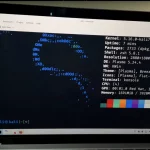 LaptopsDecember 17, 2025The 4 Best Laptops For Virtualization of 2026 (10-50 VMs ATSM)
LaptopsDecember 17, 2025The 4 Best Laptops For Virtualization of 2026 (10-50 VMs ATSM) Hardware GuideDecember 17, 20252026 Beginner Guide to Reading Computer (Laptop) Specifications
Hardware GuideDecember 17, 20252026 Beginner Guide to Reading Computer (Laptop) Specifications LaptopsJune 30, 2025Best Laptops for Computer Science (July 2025 )
LaptopsJune 30, 2025Best Laptops for Computer Science (July 2025 )
